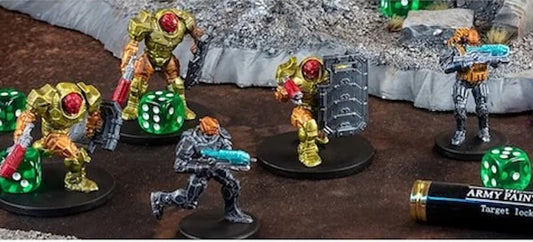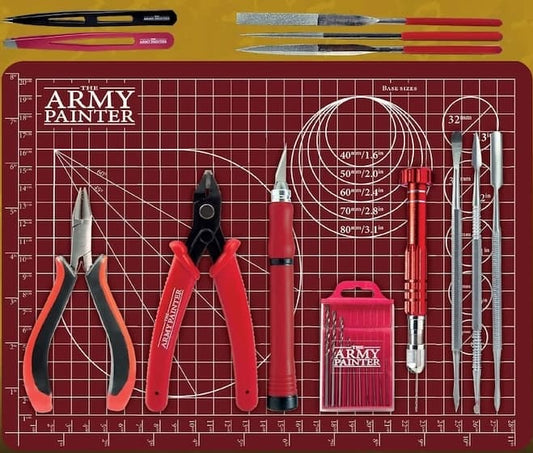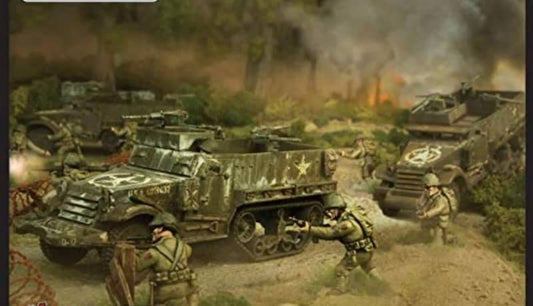Small soldiers, big fun. In miniature wargames tiny battles create huge excitement.
Players control detailed miniatures to simulate epic battles. There’s strategy, creativity, and a whole lot of fun.
Plus, you get to paint your own armies and design battlefields (tiny trees included).
Curious to learn more? Let's answer some of the most common questions about this fascinating hobby.
How is Miniature Wargaming Different from Other Types of Wargaming?
Miniature wargaming offers a more immersive experience. You paint and move tiny models, making the game feel hands-on and detailed.
As you play, you interact with real terrain and figures. This is different from the abstract nature of board games and the digital feel of video games.
You also get to customize your armies and battlefield, adding a personal touch that other wargames can’t offer.
How Do Miniature Wargames Work?
Miniature wargames might look complex with all those dice, tape measures, and miniatures, but the core principles are simple:
- Troop Types: Each side has different types of troops with unique characteristics. For example, knights might be heavily armored and good in close combat, while archers are better at ranged attacks but have less armor.
- Movement and Distance: Players use tape measures to move their troops and determine how far they can shoot. For instance, knights might move four inches, while archers can shoot up to 12 inches.
- Dice Rolls: Actions are determined by rolling dice. Troops have specific dice rolls they need to hit or defend. For example, knights might need to roll a three or higher to hit and the same to defend due to their armor.
- Turns and Combat: Players take turns moving and attacking. Combat results are determined by comparing dice rolls to the required numbers for each troop type.
What Do I Need to Start Playing Miniature Wargames?
To dive into miniature wargaming, you need a few essentials:
- Select a game that interests you, like something historical or sci-fi.
- Choose an army or faction. Each has its own style and strengths.
- Gather rulebooks and game materials to guide you on how to play and what you need for your battles.
- Don’t forget the dice and measuring tools to keep things fair and square.
- Get some miniatures, paints, and brushes. Create your unique armies, and maybe even design some cool terrain for your battles. Assembly and painting are part of the fun.
- Find some friends to play with or join a local group. If you're playing solo, some games have single-player modes too.
How Big Are Miniature Wargames?
Miniature wargames come in various sizes. The 54mm scale is one of the largest — perfect for games that focus on individual heroes. These models are big and full of detail, making them a feast for the eyes.
Then there's the 28mm scale — the crowd favorite. It's the sweet spot where you get enough detail without the models taking over your table. Perfect for miniature painting and showing off your artistic skills.
If you’re into epic battles, the 12mm to 20mm scales are your best bet. You can field massive armies without skimping on detail — like having a grand showdown on a not-so-grand table.
For those who think big in small ways, scales like 6mm or 3mm let you pack the battlefield with countless troops. These tiny warriors create epic scenes on a small stage.
What are the Best Historical Miniature Wargames for Beginners?
Starting with historical wargames can be a bit overwhelming, but here are some great recommendations to get you started:
- Bolt Action: This game covers World War II battles like Blitzkrieg and D-Day. It's easy to pick up, with accessible rules and plenty of miniatures to get you started.
- Mortem et Gloriam: Perfect for ancient battles from 2500 BC to 1500 BC. It's comprehensive and great for classical period enthusiasts.
- Black Powder: Covers the period from 1700 to 1900, including the Napoleonic Wars and the American Civil War. The rules are straightforward and perfect for musket-era battles.
- Team Yankee: Focuses on Cold War-era conflicts with a World War III twist. It offers modern weaponry and a huge range of miniatures.
What Types of Miniatures are Used in Miniature Wargames?
Miniature wargames use all sorts of models:
- Infantry units, which are the foot soldiers, come in different poses with different gear.
- Cavalry models are the mounted troops on horses or other creatures, showing off action and speed.
- Artillery and war machines are great for long-range attacks.
- Heroes and commanders come with special abilities. This also applies to monsters or creatures for fantasy games.
- Vehicles and tanks are a big part of sci-fi and historical games.
Are There Specific Rules and Mechanics for Each Miniature Wargame?
Yes, each miniature wargame has its own rules and mechanics. This makes every game unique and tailored to its theme.
For example, a sci-fi game might focus on futuristic combat with special abilities, while a historical game could emphasize realistic strategies.
Games also have expansions and updates that bring new rules, factions, and gameplay features. Staying updated keeps the game fresh and ensures there's always something new to explore.
Can I Create My Own Scenarios and Campaigns for Miniature Wargames?
Yes, creating your own scenarios and campaigns is a big part of the fun. You can design custom battles with specific goals and challenges.
Link multiple scenarios together to create a campaign. This adds depth and keeps the story going from one battle to the next.
You can also share your ideas with the gaming community to get feedback, exchange ideas, and make your games even better.
Are There Organized Events and Tournaments for Miniature Wargaming?
Yes, there are plenty of events and tournaments for miniature wargaming enthusiasts. Local game stores frequently host events, from casual gaming nights to serious tournaments.
National and international tournaments bring together top players. These competitions can be intense, with multiple rounds and lots of different opponents.
There are also narrative campaigns and story-driven events for those who enjoy a bit of plot with their battles. And let’s not forget the painting competitions that showcase amazing artistic talent.
Where Can I Find Other Miniature Wargaming Players?
Finding fellow players is key to enjoying miniature wargaming. Local game stores often host events and gaming nights, which is a perfect time to meet new opponents.
Online forums and social media groups are also great places to connect. Platforms like Reddit, Facebook, and Discord have active communities discussing all things wargaming.
Don’t forget gaming conventions and local meetups. These events are goldmines for finding like-minded enthusiasts and engaging in epic battles.
Conclusion
Hopefully, you now have a better grasp of miniature wargaming. With its detailed models, creative customization, and immersive gameplay, it offers endless enjoyment. Ready to make your move and join the miniature mayhem? Game on!
Video
Infographic
Miniature wargaming offers an immersive experience where you paint and move small models, creating a hands-on feel. While it can be overwhelming to start with historical wargames, this infographic provides useful recommendations to help you begin.




